Moran M.J., Shapiro H.N. Fundamentals of Engineering Thermodynamics
Подождите немного. Документ загружается.

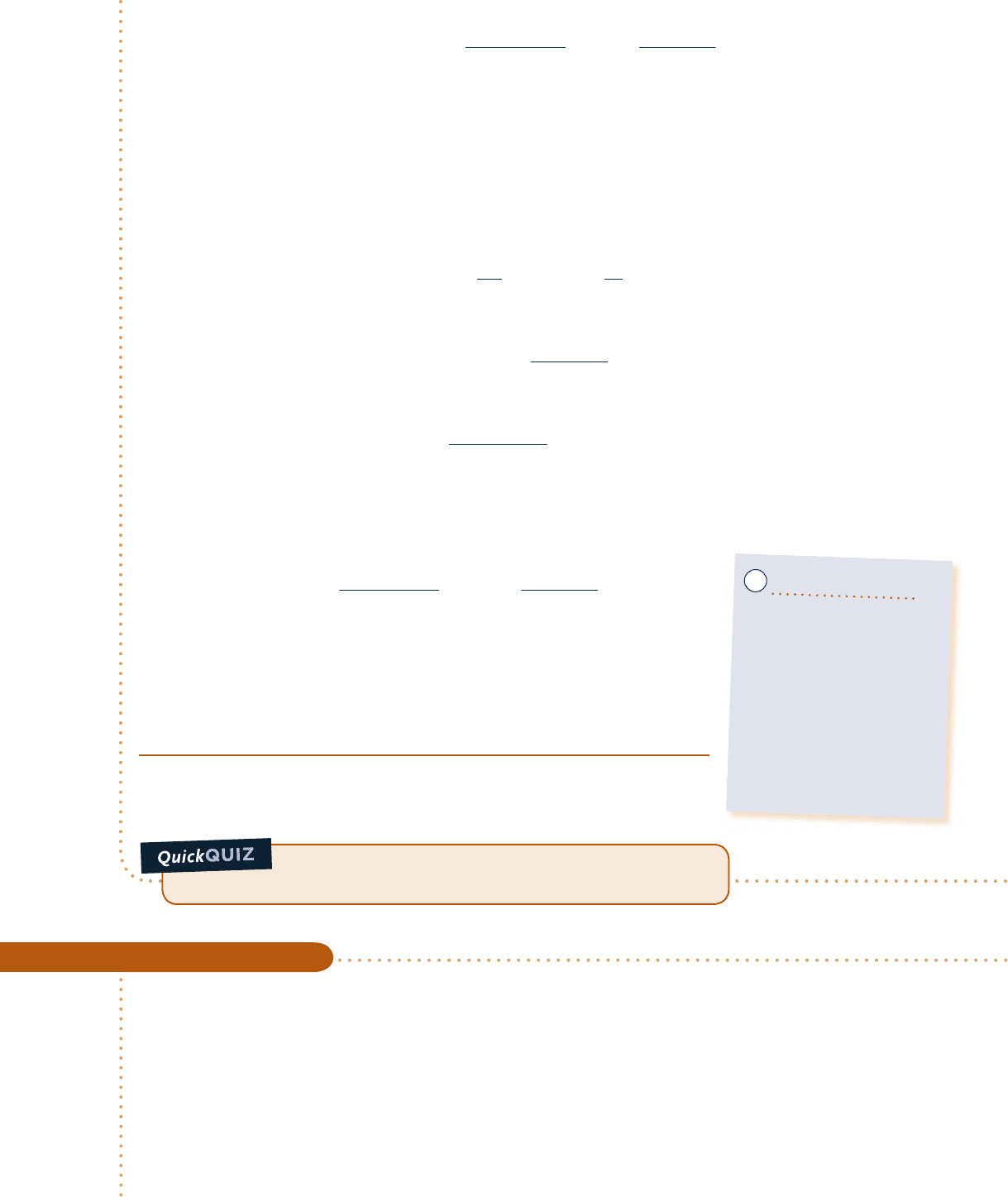
Determine the quality of the two-phase, liquid–vapor mixture and
the relative humidity of the gas phase at the final state. Ans. 47%, 100%.
Inserting values in Eq. 12.43
v
1
5 0.622
a
0.2542
14.7 2 0.2542
b
5 0.011
lb
1
vapor
2
lb
1
dry air
2
(b) The dew point temperature is the saturation temperature corresponding to the partial pressure, p
v1
. Interpolation
in Table A-2E gives T 5 608F. The dew point temperature is labeled on the accompanying property diagram.
(c) The amount of condensate, m
w
, equals the difference between the initial amount of water vapor in the
sample, m
v1
, and the final amount of water vapor, m
v2
. That is
m
w
5 m
v1
2 m
v2
To evaluate m
v1
, note that the system initially consists of 1 lb of dry air and water vapor, so 1 lb 5 m
a
1 m
v1
,
where m
a
is the mass of dry air present in the sample. Since v
1
5 m
v
1
/
m
a
, m
a
5 m
v
1
/
v
1
. With this we get
1 lb 5
m
v1
v
1
1 m
v1
5 m
v1
a
1
v
1
1 1
b
Solving for m
v1
m
v1
5
1 lb
1
1
/
v
1
2
1 1
Inserting the value of v
1
determined in part (a)
m
v1
5
1 lb
1
1
/
0.011
2
1 1
5 0.0109 lb 1vapor2
➊
The mass of dry air present is then m
a
5 1 2 0.0109 5 0.9891 lb (dry air).
Next, let us evaluate m
v2
. With assumption 3, the partial pressure of the water vapor remaining in the system
at the final state is the saturation pressure corresponding to 408F: p
g
5 0.1217 lbf/in.
2
Accordingly, the humidity
ratio after cooling is found from Eq. 12.43 as
v
2
5 0.622
a
0.1217
14.7 2 0.1217
b
5 0.0052
lb
1
vapor
2
lb
1
dry air
2
The mass of the water vapor present at the final state is then
m
v2
5 v
2
m
a
5
1
0.0052
21
0.9891
2
5 0.0051 lb
1
vapor
2
Finally, the amount of water vapor that condenses is
m
w
5 m
v1
2 m
v2
5 0.0109 2 0.0051 5 0.0058 lb
1
condensate
2
➊
The amount of water vapor present in a typical moist air mixture is consid-
erably less than the amount of dry air present.
Ability to…
❑
apply psychrometric termi-
nology and principles.
❑
demonstrate understanding
of the dew point tempera-
ture and the formation of
liquid condensate when
pressure is constant.
❑
retrieve property data for
water.
✓
Skills Developed
Cooling Moist Air at Constant Volume
c c c c EXAMPLE 12.8 c
An air–water vapor mixture is contained in a rigid, closed vessel with a volume of 35 m
3
at 1.5 bar, 1208C, and
f 5 10%. The mixture is cooled at constant volume until its temperature is reduced to 228C. Determine (a) the
dew point temperature corresponding to the initial state, in 8C, (b) the temperature at which condensation actu-
ally begins, in 8C, and (c) the amount of water condensed, in kg.
12.5 Introducing Psychrometric Principles 733
c12IdealGasMixtureandPsychromet733 Page 733 6/29/10 11:57:08 AM user-s146 c12IdealGasMixtureandPsychromet733 Page 733 6/29/10 11:57:08 AM user-s146 /Users/user-s146/Desktop/Merry_X-Mas/New/Users/user-s146/Desktop/Merry_X-Mas/New

734 Chapter 12 Ideal Gas Mixture and Psychrometric Applications
Engineering Model:
1.
The contents of the tank are taken as a
closed system. The system volume
remains constant.
2. The gas phase can be treated as an ideal gas
mixture. The Dalton model applies: Each
mixture component acts as an ideal gas
existing alone in the volume occupied by
the gas phase at the mixture temperature.
3. When a liquid water phase is present, the
water vapor exists as a saturated vapor at
the system temperature. The liquid is a
saturated liquid at the system temperature.
T
v
p
v1
T
1
f2 g2
2
1′
1
Condensation
begins
Dew point
temperature
V = 35 m
3
Boundary
Initially moist air
at 1.5 bar, 120°C
= 10%
φ
Fig. E12.8
SOLUTION
Known:
A rigid, closed tank with a volume of 35 m
3
containing moist air initially at 1.5 bar, 1208C, and f 5 10%
is cooled to 228C.
Find: Determine the dew point temperature at the initial state, in 8C, the temperature at which condensation
actually begins, in 8C, and the amount of water condensed, in kg.
Schematic and Given Data:
Analysis:
(a)
The dew point temperature at the initial state is the saturation temperature corresponding to the partial
pressure p
v1
. With the given relative humidity and the saturation pressure at 1208C from Table A-2
p
v1
5 f
1
p
g1
5 10.10211.98525 0.1985 bar
Interpolating in Table A-2 gives the dew point temperature as 608C, which is the temperature condensation would
begin if the moist air were cooled at constant pressure.
(b) Whether the water exists as a vapor only, or as liquid and vapor, it occupies the full volume, which remains
constant. Accordingly, since the total mass of the water present is also constant, the water undergoes the con-
stant specific volume process illustrated on the accompanying T–y diagram. In the process from state 1 to
state 19, the water exists as a vapor only. For the process from state 19 to state 2, the water exists as a two-
phase liquid–vapor mixture. Note that pressure does not remain constant during the cooling process from state
1 to state 2.
State 19 on the T–y diagram denotes the state where the water vapor first becomes saturated. The satura-
tion temperature at this state is denoted as T9. Cooling to a temperature less than T9 results in condensation
of some of the water vapor present. Since state 19 is a saturated vapor state, the temperature T9 can be found
by interpolating in Table A-2 with the specific volume of the water at this state. The specific volume of the
vapor at state 19 equals the specific volume of the vapor at state 1, which can be evaluated from the ideal gas
equation
y
v1
5
1
R
/
M
v
2T
1
p
v1
5 a
8314
18
N ? m
k
g
? K
b a
393 K
0.1985 3 10
5
N
/
m
2
b
5 9.145
m
3
k
g
➊
Interpolation in Table A-2 with y
v1
5 y
g
gives T9 5 568C. This is the temperature at which condensation
begins.
(c) The amount of condensate equals the difference between the initial and final amounts of water vapor present.
The mass of the water vapor present initially is
m
v1
5
V
y
v1
5
35 m
3
9.145 m
3
/
k
g
5 3.827 kg
c12IdealGasMixtureandPsychromet734 Page 734 6/29/10 11:57:12 AM user-s146 c12IdealGasMixtureandPsychromet734 Page 734 6/29/10 11:57:12 AM user-s146 /Users/user-s146/Desktop/Merry_X-Mas/New/Users/user-s146/Desktop/Merry_X-Mas/New

Determine the humidity ratio at the initial state and the amount
of dry air present, in kg. Ans. 0.0949, 40.389 kg.
The mass of water vapor present finally can be determined from the quality. At the final state, the water forms
a two-phase liquid–vapor mixture having a specific volume of 9.145 m
3
/kg. Using this specific volume value, the
quality x
2
of the liquid–vapor mixture can be found as
x
2
5
y
v2
2 y
f 2
y
g
2
2 y
f2
5
9.145 2 1.0022 3 10
23
51.447 2 1.0022 3 10
23
5 0.178
where y
f2
and y
g2
are the saturated liquid and saturated vapor specific volumes at T
2
5 228C, respectively.
Using the quality together with the known total amount of water present,
3.827 kg, the mass of the water vapor contained in the system at the final
state is
m
v2
5
1
0.178
21
3.827
2
5 0.681 kg
The mass of the condensate, m
w2
, is then
m
w2
5 m
v1
2 m
v2
5 3.827 2 0.681 5 3.146 k
g
➊
When a moist air mixture is cooled at constant mixture volume, the tem-
perature at which condensation begins is not the dew point temperature
corresponding to the initial state. In this case, condensation begins at 568C,
but the dew point temperature at the initial state, determined in part (a),
is 608C.
Ability to…
❑
apply psychrometric termi-
nology and principles.
❑
demonstrate understanding
of the onset of condensa-
tion when cooling moist air
at constant volume.
❑
retrieve property data for
water.
✓
Skills Developed
No additional fundamental concepts are required for the study of closed systems
involving mixtures of dry air and water vapor. Example 12.9, which builds on Exam-
ple 12.8, brings out some special features of the use of conservation of mass and
conservation of energy in analyzing this kind of system. Similar considerations can
be used to study other closed systems involving moist air.
Evaluating Heat Transfer for Moist Air Cooling at Constant Volume
c c c c EXAMPLE 12.9 c
An air–water vapor mixture is contained in a rigid, closed vessel with a volume of 35 m
3
at 1.5 bar, 1208C, and
f 5 10%. The mixture is cooled until its temperature is reduced to 228C. Determine the heat transfer during
the process, in kJ.
SOLUTION
Known:
A rigid, closed tank with a volume of 35 m
3
containing moist air initially at 1.5 bar, 1208C, and f 5 10%
is cooled to 228C.
Find: Determine the heat transfer for the process, in kJ.
Schematic and Given Data: See the figure for Example 12.8.
Engineering Model:
1.
The contents of the tank are taken as a closed system. The system volume remains constant.
2. The gas phase can be treated as an ideal gas mixture. The Dalton model applies: Each component acts as
an ideal gas existing alone in the volume occupied by the gas phase at the mixture temperature.
12.5 Introducing Psychrometric Principles 735
c12IdealGasMixtureandPsychromet735 Page 735 6/29/10 11:57:15 AM user-s146 c12IdealGasMixtureandPsychromet735 Page 735 6/29/10 11:57:15 AM user-s146 /Users/user-s146/Desktop/Merry_X-Mas/New/Users/user-s146/Desktop/Merry_X-Mas/New

736 Chapter 12 Ideal Gas Mixture and Psychrometric Applications
Calculate the change in internal energy of the dry air, in kJ,
assuming a constant specific heat c
ya
interpolated from Table A-20 at the
average of the initial and final temperatures. Ans. 22854 kJ.
3. When a liquid water phase is present, the water vapor exists as a saturated vapor and the liquid is a satu-
rated liquid, each at the system temperature.
4. There is no work during the cooling process and no change in kinetic or potential energy.
Analysis: Reduction of the closed system energy balance using assumption 4 results in
¢U 5 Q 2 W
0
or
Q
5 U
2
2 U
1
where
U
1
5 m
a
u
a1
1 m
v1
u
v1
5 m
a
u
a1
1 m
v1
u
g
1
and
U
2
5 m
a
u
a2
1 m
v2
u
v2
1 m
w2
u
w2
5 m
a
u
a2
1 m
v2
u
g
2
1 m
w2
u
f2
In these equations, the subscripts a, v, and w denote, respectively, dry air, water vapor, and liquid water.
The specific internal energy of the water vapor at the initial state can be approximated as the saturated
vapor value at T
1
. At the final state, the water vapor is assumed to exist as a saturated vapor, so its specific
internal energy is u
g
at T
2
. The liquid water at the final state is saturated, so its specific internal energy is
u
f
at T
2
.
Collecting the last three equations
➊
Q 5 m
a
1u
a2
2 u
a1
21 m
v2
u
g2
1 m
w2
u
f2
2 m
v1
u
g1
The mass of dry air, m
a
, can be found using the ideal gas equation of state together with the partial pres-
sure of the dry air at the initial state obtained using p
v1
5 0.1985 bar from the solution to Example 12.8 as
follows:
m
a
5
p
a1
V
1
R
/
M
a
2
T
1
5
311.5 2 0.198523 10
5
N
/
m
2
4135 m
3
2
1
8314
/
28.97 N ? m
/
kg ? K
21
393 K
2
5 40.389 k
g
Then, evaluating internal energies of dry air and water from Tables A-22 and A-2, respectively
Q 5 40.389
1
210.49 2 281.1
2
1 0.681
1
2405.7
2
1 3.146
1
92.32
2
2 3.827
1
2529.3
2
522851.87 1 1638.28 1 290.44 2 9679.63 5210,603 kJ
The values for m
v1
, m
v2
, and m
w2
are from the solution to Example 12.8.
➊
The first underlined term in this equation for Q is evaluated with specific
internal energies from the ideal gas table for air, Table A-22. Steam table
data are used to evaluate the second underlined term. The different
datums for internal energy underlying these tables cancel because each
of these two terms involves internal energy differences. Since the specific
heat c
ya
for dry air varies only slightly over the interval from 120 to 228C
(Table A-20), the specific internal energy change of the dry air could be
evaluated alternatively using a constant c
ya
value. See the QuickQuiz that
follows.
Ability to…
❑
apply psychrometric termi-
nology and principles.
❑
apply the energy balance to
the cooling of moist air at
constant volume.
❑
retrieve property data for
water.
✓
Skills Developed
c12IdealGasMixtureandPsychromet736 Page 736 6/29/10 11:57:16 AM user-s146 c12IdealGasMixtureandPsychromet736 Page 736 6/29/10 11:57:16 AM user-s146 /Users/user-s146/Desktop/Merry_X-Mas/New/Users/user-s146/Desktop/Merry_X-Mas/New

12.5.5 Evaluating Humidity Ratio Using the Adiabatic-
Saturation Temperature
The humidity ratio v of an air–water vapor mixture can be determined, in principle,
knowing the values of three mixture properties: the pressure p, the temperature T,
and the adiabatic-saturation temperature T
as
introduced in this section. The relationship
among these mixture properties is obtained by applying conservation of mass and
conservation of energy to an adiabatic saturator (see box).
Equations 12.48 and 12.49 give the humidity ratio v in terms of the adiabatic-
saturation temperature and other quantities:
v 5
h
a
1T
as
22 h
a
1T21 v¿3h
g
1T
as
22 h
f
1T
as
24
h
g
1T22 h
f
1T
as
2
(12.48)
where h
f
and h
g
denote the enthalpies of saturated liquid water and saturated water
vapor, respectively, obtained from the steam tables at the indicated temperatures. The
enthalpies of the dry air h
a
can be obtained from the ideal gas table for air. Alterna-
tively, h
a
(T
as
) 2 h
a
(T) 5 c
pa
(T
as
2 T), where c
pa
is an appropriate constant value for
the specific heat of dry air. The humidity ratio v9 appearing in Eq. 12.48 is
v¿ 5 0.622
p
g
1
T
as
2
p 2 p
g
1T
as
2
(12.49)
where p
g
(T
as
) is the saturation pressure at the adiabatic-saturation temperature and
p is the mixture pressure.
adiabatic-saturation
temperature
Modeling an Adiabatic Saturator
Figure 12.7 shows the schematic and process representations of an adiabatic saturator, which
is a two-inlet, single-exit device through which moist air passes. The device is assumed to
operate at steady state and without significant heat transfer with its surroundings. An air–water
vapor mixture of unknown humidity ratio
v enters the adiabatic saturator at a known pressure
p and temperature T. As the mixture passes through the device, it comes into contact with a
pool of water. If the entering mixture is not saturated (
f , 100%), some of the water would
evaporate. The energy required to evaporate the water would come from the moist air, so the
mixture temperature would decrease as the air passes through the duct. For a sufficiently long
duct, the mixture would be saturated as it exits (
f 5 100%). Since a saturated mixture would
be achieved without heat transfer with the surroundings, the temperature of the exiting mixture
is the adiabatic-saturation temperature. As indicated on Fig. 12.7, a steady flow of makeup
water at temperature T
as
is added at the same rate at which water is evaporated. The pressure
of the mixture is assumed to remain constant as it passes through the device.
Equation 12.48 giving the humidity ratio
v of the entering moist air in terms of p, T,
and T
as
can be obtained by applying conservation of mass and conservation of energy to
the adiabatic saturator, as follows:
At steady state, the mass flow rate of the dry air entering the device,
?
m
a
, must equal the
mass flow rate of the dry air exiting. The mass flow rate of the makeup water is the difference
between the exiting and entering vapor flow rates denoted by
?
m
v
and
?
m9
v
, respectively. These
flow rates are labeled on Fig. 12.7a. At steady state, the energy rate balance reduces to
(m
#
a
h
a
1 m
#
v
h
v
)
moist air
entering
1 [(m
#
¿
v
2 m
#
v
)h
w
]
makeup
water
5 (m
#
a
h
a
1 m
#
¿
v
h
v
)
moist air
exiting
Several assumptions underlie this expression: Each of the two moist air streams is mod-
eled as an ideal gas mixture of dry air and water vapor. Heat transfer with the surroundings
12.5 Introducing Psychrometric Principles 737
c12IdealGasMixtureandPsychromet737 Page 737 6/29/10 11:57:19 AM user-s146 c12IdealGasMixtureandPsychromet737 Page 737 6/29/10 11:57:19 AM user-s146 /Users/user-s146/Desktop/Merry_X-Mas/New/Users/user-s146/Desktop/Merry_X-Mas/New
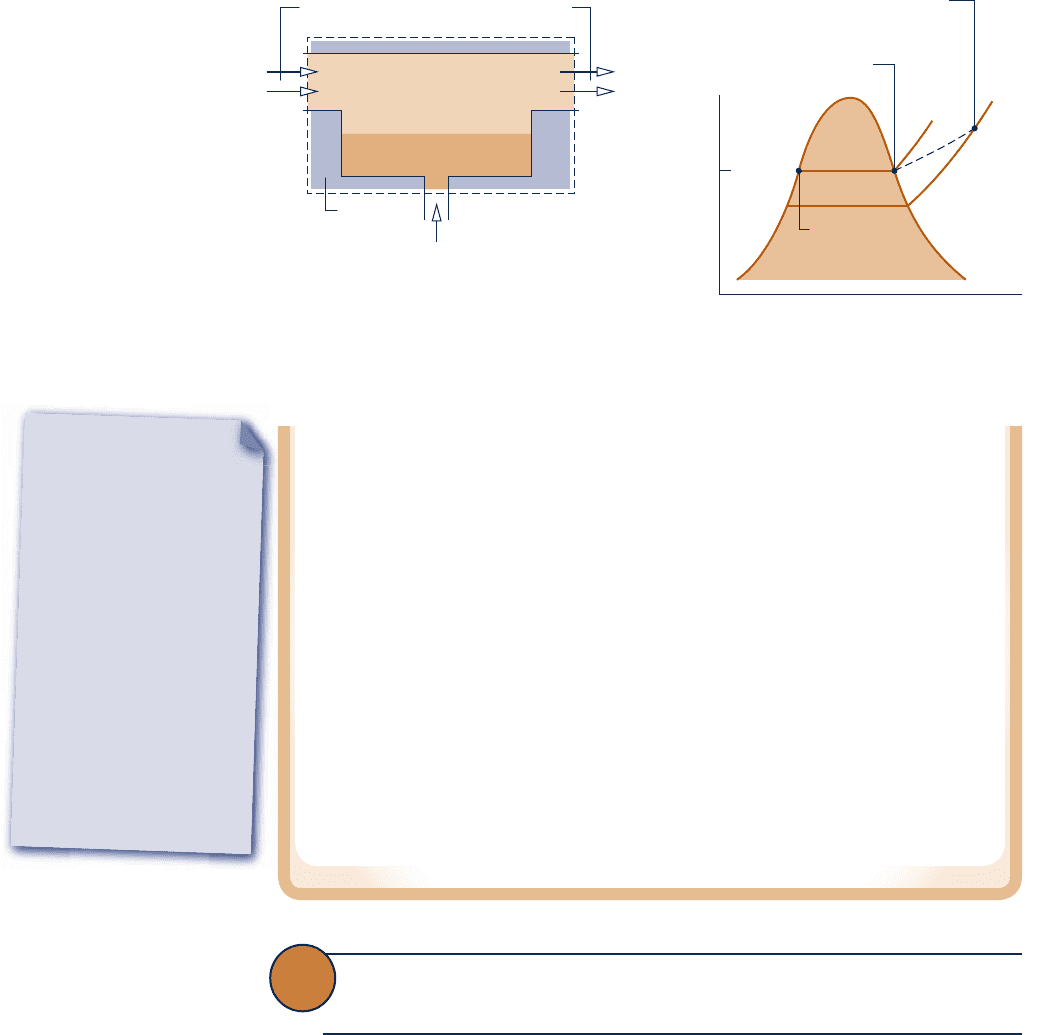
738 Chapter 12
Ideal Gas Mixture and Psychrometric Applications
Fig. 12.7
Adiabatic saturator. (a) Schematic. (b) Process representation.
T
T
as
v
p
g
(T
as
)
State of the water vapor
in the incoming moist air stream
State of the water
vapor in the
exiting moist air
stream
State of the
makeup water
Makeup water —
saturated liquid at T
as
,
mass flow rate = m
·
′
v
– m
·
v
Insulation
Moist air
p, T,
ω
Saturated mixture
T
as
, ′, p
ω
m
·
a
m
·
v
m
·
a
m
·
′
v
(a)(b)
12.6 Psychrometers: Measuring the Wet-Bulb
and Dry-Bulb Temperatures
For moist air mixtures in the normal pressure and temperature ranges of psychro-
metrics, the readily-measured wet-bulb temperature is an important parameter.
The wet-bulb temperature is read from a wet-bulb thermometer, which is an ordi-
nary liquid-in-glass thermometer whose bulb is enclosed by a wick moistened with
water. The term dry-bulb temperature refers simply to the temperature that would be
measured by a thermometer placed in the mixture. Often a wet-bulb thermometer
is mounted together with a dry-bulb thermometer to form an instrument called a
psychrometer.
The psychrometer of Fig. 12.8a is whirled in the air whose wet- and dry-bulb
temperatures are to be determined. This induces air flow over the two thermometers.
For the psychrometer of Fig. 12.8b, the air flow is induced by a battery-operated fan.
psychrometer
wet-bulb temperature
dry-bulb temperature
TAKE NOTE...
Although derived with
reference to the adiabatic
saturator in Fig. 12.7, the
relationship provided by
Eq. 12.48 applies generally
to moist air mixtures and
is not restricted to this
type of system or even to
control volumes. The rela-
tionship allows the humidity
ratio
v
to be determined
for any moist air mixture
for which the pressure p,
temperature T, and
adiabatic-saturation tem-
perature T
as
are known.
is assumed to be negligible. There is no work
?
W
cv
, and changes in kinetic and potential
energy are ignored.
Dividing by the mass flow rate of the dry air,
?
m
a
, the energy rate balance can be written
on the basis of a unit mass of dry air passing through the device as
(
h
a
1 vh
g
)
moist air
entering
1 [
(
v¿ 2 v
)
h
f
]
makeup
water
5
(
h
a
1 v¿h
g
)
moist air
exiting
(12.50)
where v 5
?
m
v
y
?
m
a
and v9 5
?
m9
v
y
?
m
a
.
For the exiting saturated mixture, the partial pressure of the water vapor is the satura-
tion pressure corresponding to the adiabatic-saturation temperature, p
g
(T
as
). Accordingly,
the humidity ratio
v9 can be evaluated knowing T
as
and the mixture pressure p, as indi-
cated by Eq. 12.49. In writing Eq. 12.50, the specific enthalpy of the entering water vapor
has been evaluated as that of saturated water vapor at the temperature of the incoming
mixture, in accordance with Eq. 12.47. Since the exiting mixture is saturated, the enthalpy
of the water vapor at the exit is given by the saturated vapor value at T
as
. The enthalpy
of the makeup water is evaluated as that of saturated liquid at T
as
.
When Eq. 12.50 is solved for
v, Eq. 12.48 results. The details of the solution are left
as an exercise.
c12IdealGasMixtureandPsychromet738 Page 738 6/29/10 11:57:21 AM user-s146 c12IdealGasMixtureandPsychromet738 Page 738 6/29/10 11:57:21 AM user-s146 /Users/user-s146/Desktop/Merry_X-Mas/New/Users/user-s146/Desktop/Merry_X-Mas/New
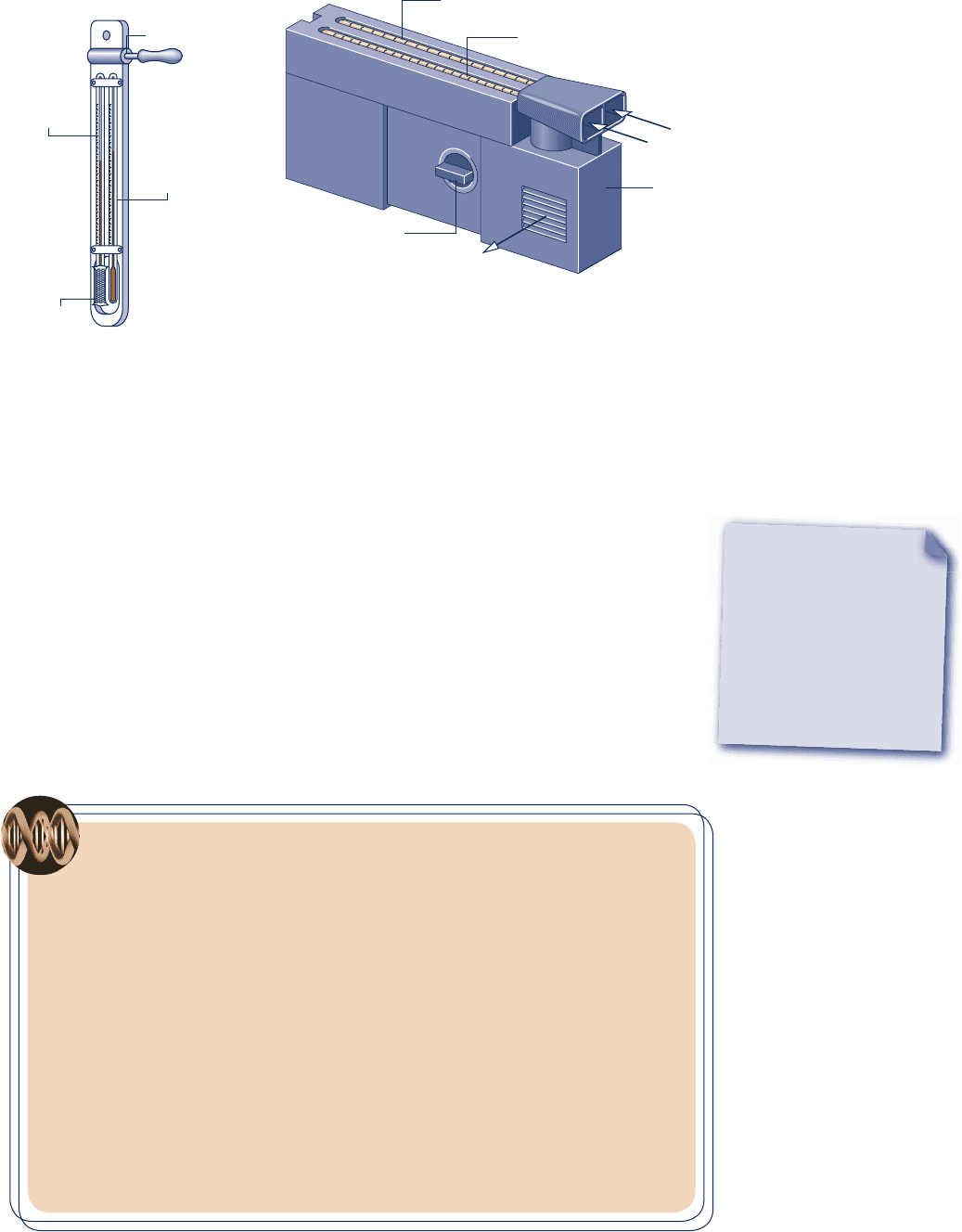
Air in
Air out
Battery-
operated
fan
Dry-bulb
thermometer
Wet-bulb
thermometer
Switch
(b)
Bearing
Handle
Wet-bulb
thermometer
Dry-bulb
thermometer
Wick
(a)
Fig. 12.8 Psychrometers. (a) Sling psychrometer. (b) Aspirating psychrometer.
In each type of psychrometer, if the surrounding air is not saturated, water in the
wick of the wet-bulb thermometer evaporates and the temperature of the remain-
ing water falls below the dry-bulb temperature. Eventually a steady-state condition
is attained by the wet-bulb thermometer. The wet- and dry-bulb temperatures are
then read from the respective thermometers. The wet-bulb temperature depends
on the rates of heat and mass transfer between the moistened wick and the air.
Since these depend in turn on the geometry of the thermometer, air velocity, sup-
ply water temperature, and other factors, the wet-bulb temperature is not a mixture
property.
For moist air mixtures in the normal pressure and temperature ranges of psychro-
metric applications, the adiabatic saturation temperature introduced in Sec. 12.5.5 is
closely approximated by the wet-bulb temperature. Accordingly, the humidity ratio
for any such mixture can be calculated by using the wet-bulb temperature in Eqs.
12.48 and 12.49 in place of the adiabatic-saturation temperature. Close agreement
between the adiabatic-saturation and wet-bulb temperatures is not generally found
for moist air departing from normal psychrometric conditions.
BIOCONNECTIONS The National Weather Service is finding better ways to
help measure our misery during cold snaps so we can avoid weather dangers. The
wind chill index, for many years based on a single 1945 study, has been upgraded
using new physiological data and computer modeling to better reflect the perils of cold
winds and freezing temperatures.
The new wind chill index is a standardized “temperature” that accounts for both the
actual air temperature and the wind speed. The formula on which it is based uses measure-
ments of skin tissue thermal resistance and computer models of the wind patterns over the
human face, together with principles of heat transfer. Using the new index, an air tem-
perature of 5
8F and a wind speed of 25 miles per hour correspond to a wind chill tem-
perature of
2408F. The old index assigned a wind chill of only 2208F to the same condi-
tions. With the new information, people are better armed to avoid exposure that can lead
to such serious medical problems as frostbite.
The improved measure was developed by universities, international scientific societies,
and government in an effort that led to the new standard being adopted in the United
States. Further upgrades are in the works to include the amount of cloud cover in the
formula, since solar radiation is also an important factor in how cold it feels.
TAKE NOTE...
The humidity ratio for
moist air mixtures consid-
ered in this book can be
calculated by using the
wet-bulb temperature in
Eqs. 12.48 and 12.49 in
place of the adiabatic
saturation temperature.
12.6 Psychrometers: Measuring the Wet-Bulb and Dry-Bulb Temperatures 739
c12IdealGasMixtureandPsychromet739 Page 739 6/29/10 11:57:24 AM user-s146 c12IdealGasMixtureandPsychromet739 Page 739 6/29/10 11:57:24 AM user-s146 /Users/user-s146/Desktop/Merry_X-Mas/New/Users/user-s146/Desktop/Merry_X-Mas/New
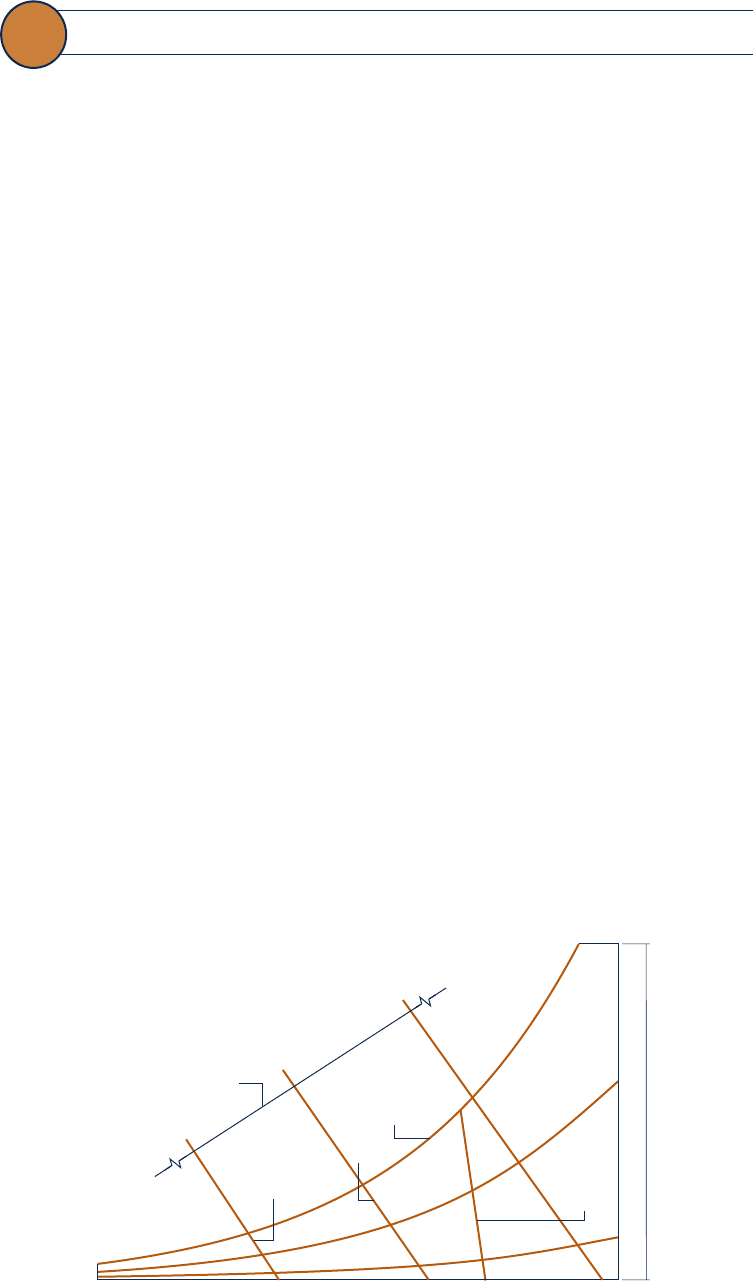
740 Chapter 12
Ideal Gas Mixture and Psychrometric Applications
= 100%
φ
= 50%
φ
= 10%
φ
Volume
per unit
mass of
dry air
T
wb
T
wb
T
wb
Wet-bulb and
dew point
temperature
scales
Scale for the
mixture enthalpy
per unit mass of
dry air
Barometric pressure = 1 atm
Dry-bulb temperature
ω
p
v
Fig. 12.9 Psychrometric chart.
12.7 Psychrometric Charts
Graphical representations of several important properties of moist air are provided by
psychrometric charts. The main features of one form of chart are shown in Fig. 12.9. Com-
plete charts in SI and English units are given in Figs. A-9 and A-9E. These charts are
constructed for a mixture pressure of 1 atm, but charts for other mixture pressures are
also available. When the mixture pressure differs only slightly from 1 atm, Figs. A-9 remain
sufficiently accurate for engineering analyses. In this text, such differences are ignored.
Let us consider several features of the psychrometric chart:
c Referring to Fig. 12.9, note that the abscissa gives the dry-bulb temperature and
the ordinate provides the humidity ratio. For charts in SI, the temperature is in 8C
and v is expressed in kg, or g, of water vapor per kg of dry air. Charts in English
units give temperature in 8F and v in lb, or grains, of water vapor per lb of dry
air, where 1 lb 5 7000 grains.
c Equation 12.43 shows that for fixed mixture pressure there is a direct correspondence
between the partial pressure of the water vapor and the humidity ratio. Accordingly,
the vapor pressure also can be shown on the ordinate, as illustrated on Fig. 12.9.
c Curves of constant relative humidity are shown on psychrometric charts. On Fig. 12.9,
curves labeled f 5 100, 50, and 10% are indicated. Since the dew point is the state where
the mixture becomes saturated when cooled at constant vapor pressure, the dew point
temperature corresponding to a given moist air state can be determined by following a
line of constant v (constant p
v
) to the saturation line, f 5 100%. The dew point tem-
perature and dry-bulb temperature are identical for states on the saturation curve.
c Psychrometric charts also give values of the mixture enthalpy per unit mass of dry air
in the mixture: h
a
1 vh
v
. In Figs. A-9 and A-9E, the mixture enthalpy has units of kJ
per kg of dry air and Btu per lb of dry air, respectively. The numerical values provided
on these charts are determined relative to the following special reference states and
reference values. In Fig. A-9, the enthalpy of the dry air h
a
is determined relative to a
zero value at 08C, and not 0 K as in Table A-22. Accordingly, in place of Eq. 3.49 used
to develop the enthalpy data of Tables A-22, the following expression is employed to
evaluate the enthalpy of the dry air for use on the psychrometric chart:
h
a
5
#
T
273.15 K
c
p
a
dT 5 c
p
a
T18C2
(12.51)
psychrometric chart
c12IdealGasMixtureandPsychromet740 Page 740 6/29/10 11:57:27 AM user-s146 c12IdealGasMixtureandPsychromet740 Page 740 6/29/10 11:57:27 AM user-s146 /Users/user-s146/Desktop/Merry_X-Mas/New/Users/user-s146/Desktop/Merry_X-Mas/New
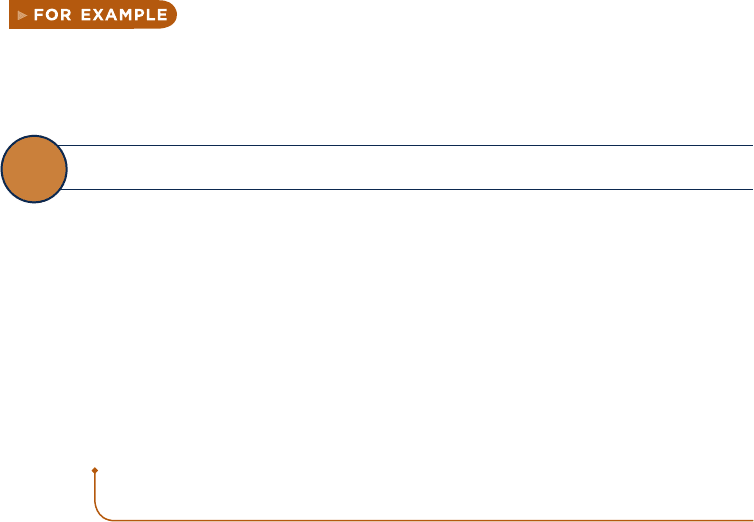
where c
pa
is a constant value for the specific heat c
p
of dry air and T(8C) denotes
the temperature in 8C. For the chart in English units, Fig. A-9E, h
a
is determined
relative to a datum of 08F, using h
a
5 c
pa
T(8F), where T(8F) denotes the tempera-
ture in 8F. In the temperature ranges of Figs. A-9 and A-9E, c
pa
can be taken as
1.005 kJ/kg ? K and 0.24 Btu/lb ? 8R, respectively. On Figs. A-9 the enthalpy of the
water vapor h
v
is evaluated as h
g
at the dry-bulb temperature of the mixture from
Table A-2 or A-2E, as appropriate.
c Another important parameter on psychrometer charts is the wet-bulb temperature.
As illustrated by Figs. A-9, constant T
wb
lines run from the upper left to the lower
right of the chart. The relationship between the wet-bulb temperature and other
chart quantities is provided by Eq. 12.48. The wet-bulb temperature can be used
in this equation in place of the adiabatic-saturation temperature for the states of
moist air located on Figs. A-9.
c Lines of constant wet-bulb temperature are approximately lines of constant mixture
enthalpy per unit mass of dry air. This feature can be brought out by study of the
energy balance for the adiabatic saturator, Eq. 12.50. Since the contribution of the
energy entering the adiabatic saturator with the makeup water is normally much
smaller than that of the moist air, the enthalpy of the entering moist air is very nearly
equal to the enthalpy of the saturated mixture exiting. Accordingly, all states with the
same value of the wet-bulb temperature (adiabatic-saturation temperature) have nearly
the same value for the mixture enthalpy per unit mass of dry air. Although Figs. A-9
ignore this slight effect, some psychrometric charts are drawn to show the departure
of lines of constant wet-bulb temperature from lines of constant mixture enthalpy.
c As shown on Fig. 12.9, psychrometric charts also provide lines representing volume
per unit mass of dry air, V/m
a
. Figures A-9 and A-9E give this quantity in units of
m
3
/kg and ft
3
/lb, respectively. These specific volume lines can be interpreted as
giving the volume of dry air or of water vapor, per unit mass of dry air, since each
mixture component is considered to fill the entire volume.
The psychrometric chart is easily used.
a psychrometer indicates that in a classroom the dry-bulb tem-
perature is 688F and the wet-bulb temperature is 608F. Locating the mixture state
on Fig. A-9E corresponding to the intersection of these temperatures, we read v 5
0.0092 lb(vapor)/lb(dry air) and f 5 63%. b b b b b
12.8 Analyzing Air-Conditioning Processes
The purpose of the present section is to study typical air-conditioning processes using
the psychrometric principles developed in this chapter. Specific illustrations are provided
in the form of solved examples involving control volumes at steady state. In each exam-
ple, the methodology introduced in Sec. 12.8.1 is employed to arrive at the solution.
To reinforce principles developed in this chapter, the psychrometric parameters
required by these examples are determined in most cases using tabular data from
Appendix tables. Where a full psychrometric chart solution is not also provided, we
recommend the example be solved using the chart, checking results with values from
the solution presented.
12.8.1 Applying Mass and Energy Balances
to Air-Conditioning Systems
The object of this section is to illustrate the use of the conservation of mass and
conservation of energy principles in analyzing systems involving mixtures of dry air
and water vapor in which a condensed water phase may be present. The same basic
12.8 Analyzing Air-Conditioning Processes 741
c12IdealGasMixtureandPsychromet741 Page 741 6/29/10 11:57:28 AM user-s146 c12IdealGasMixtureandPsychromet741 Page 741 6/29/10 11:57:28 AM user-s146 /Users/user-s146/Desktop/Merry_X-Mas/New/Users/user-s146/Desktop/Merry_X-Mas/New
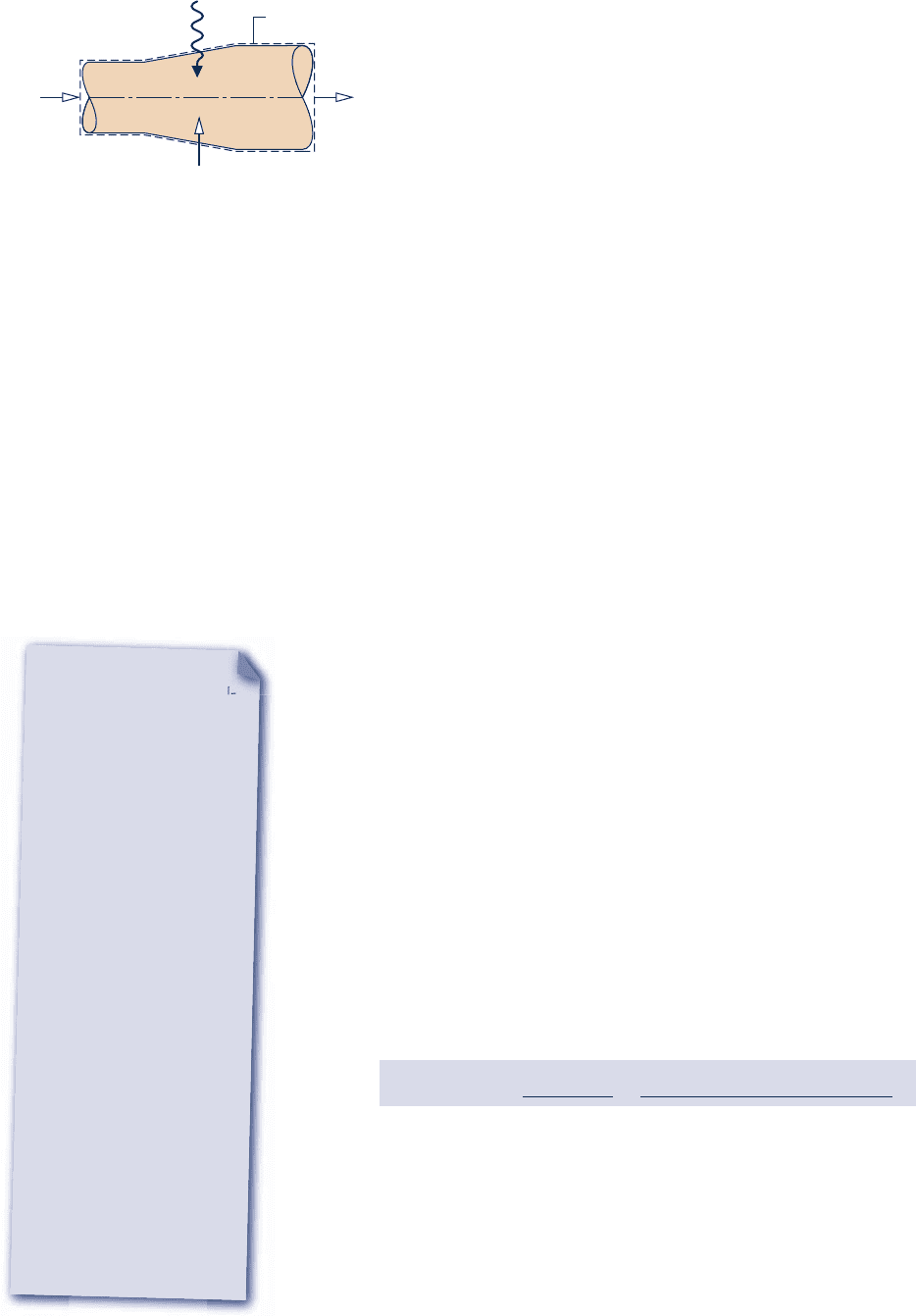
742 Chapter 12 Ideal Gas Mixture and Psychrometric Applications
solution approach that has been used in thermodynamic analyses con-
sidered thus far is applicable. The only new aspect is the use of the
special vocabulary and parameters of psychrometrics.
Systems that accomplish air-conditioning processes such as heating,
cooling, humidification, or dehumidification are normally analyzed on a
control volume basis. To consider a typical analysis, refer to Fig. 12.10,
which shows a two-inlet, single-exit control volume at steady state. A
moist air stream enters at 1, a moist air stream exits at 2, and a water-
only stream enters (or exits) at 3. The water-only stream may be a liquid
or a vapor. Heat transfer at the rate
Q
#
cv
can occur between the control
volume and its surroundings. Depending on the application, the value of
Q
#
cv
might be positive, negative, or zero.
Mass Balance
At steady state, the amounts of dry air and water vapor contained within the control
volume cannot vary. Thus, for each component individually it is necessary for the total
incoming and outgoing mass flow rates to be equal. That is
m
#
a1
5 m
#
a2
1
dry air
2
m
#
v1
1 m
#
w
5 m
#
v2
1
water
2
For simplicity, the constant mass flow rate of the dry air is denoted by m
#
a
. The mass
flow rates of the water vapor can be expressed conveniently in terms of humidity
ratios as m
#
v1
5 v
1
m
#
a
and m
#
v2
5 v
2
m
#
a
. With these expressions, the mass balance for
water becomes
m
#
w
5 m
#
a
1
v
2
2 v
1
2
1
water
2
(12.52)
When water is added at 3, v
2
is greater than v
1
.
Energy Balance
Assuming W
#
cv
5 0 and ignoring all kinetic and potential energy effects, the energy
rate balance reduces at steady state to
0 5 Q
#
cv
1
1
m
#
a
h
a1
1 m
#
v1
h
v1
2
1 m
#
w
h
w
2
1
m
#
a
h
a2
1 m
#
v2
h
v2
2
(12.53)
In this equation, the entering and exiting moist air streams are regarded as ideal gas
mixtures of dry air and water vapor.
Equation 12.53 can be cast into a form that is particularly convenient for the
analysis of air-conditioning systems. First, with Eq. 12.47 the enthalpies of the enter-
ing and exiting water vapor can be evaluated as the saturated vapor enthalpies cor-
responding to the temperatures T
1
and T
2
, respectively, giving
0 5 Q
#
cv
1 1m
#
a
h
a1
1 m
#
v1
h
g1
21 m
#
w
h
w
2 1m
#
a
h
a2
1 m
#
v2
h
g2
2
Then, with m
#
v1
5 v
1
m
#
a
and m
#
v2
5 v
2
m
#
a
, the equation can be expressed as
0 5 Q
#
cv
1 m
#
a
1h
a1
1 v
1
h
g
1
21 m
#
w
h
w
2 m
#
a
1h
a2
1 v
2
h
g
2
2 (12.54)
Finally, introducing Eq. 12.52, the energy rate balance becomes
0 5 Q
#
cv
1 m
#
a
3
1
h
a1
2 h
a2
2
1 v
1
h
g1
1 1v
2
2 v
1
2h
w
2 v
2
h
g2
4 (12.55)
The first underlined term of Eq. 12.55 can be evaluated from Tables A-22 giving
the ideal gas properties of air. Alternatively, since relatively small temperature differ-
ences are normally encountered in the class of systems under present consideration,
this term can be evaluated as h
a1
2 h
a2
5 c
pa
(T
1
2 T
2
), where c
pa
is a constant value
for the specific heat of dry air. The second underlined term of Eq. 12.55 can be
evaluated using steam table data together with known values for v
1
and v
2
. As illus-
trated in discussions to follow, Eq. 12.55 also can be evaluated using the psychromet-
ric chart or IT.
Liquid or vapor, m
·
w
Boundary
Moist air
m
·
a
,
m
·
v1
1
2
3
Moist air
m
·
a
, m
·
v2
Q
·
cv
Fig. 12.10 System for conditioning moist air.
TAKE NOTE...
As indicated by the devel-
opments of Sec. 12.8.1,
several simplifying assump-
tions are made when ana-
lyzing air-conditioning
systems considered in
Examples 12.10–12.14
to follow. They include:
c
The control volume is at
steady-state.
c
Moist air streams are
ideal gas mixtures of dry
air and water vapor adher-
ing to the Dalton model.
c
Flow is one-dimensional
where mass crosses the
boundary of the control
volume, and the effects of
kinetic and potential energy
at these locations are
neglected.
c
The only work is flow
work (Sec. 4.4.2) where
mass crosses the boundary
of the control volume.
c12IdealGasMixtureandPsychromet742 Page 742 7/23/10 7:06:20 PM user-s146 c12IdealGasMixtureandPsychromet742 Page 742 7/23/10 7:06:20 PM user-s146 /Users/user-s146/Desktop/Merry_X-Mas/New/Users/user-s146/Desktop/Merry_X-Mas/New
